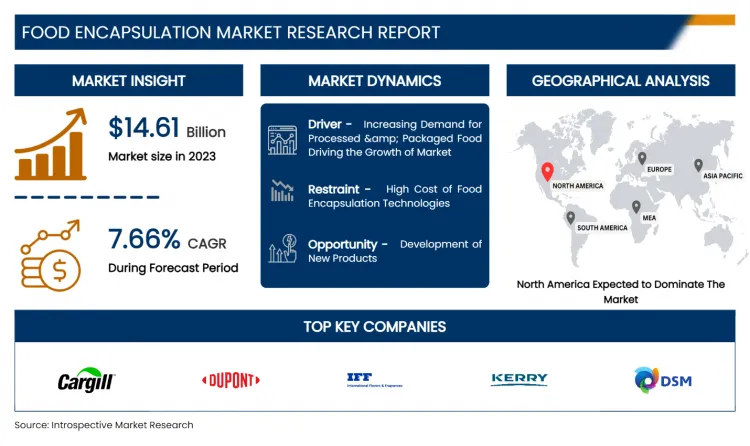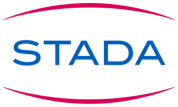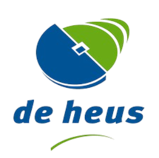Global Food Encapsulation Market Overview
Food Encapsulation Market Size Was Valued at USD 14.61 Billion in 2023 and is Projected to Reach USD 28.39 Billion by 2032, Growing at a CAGR of 7.66% From 2024-2032.
Encapsulation includes the incorporation of food ingredients, organic acids, additives, essential oils, enzymes, cells or other shell materials in small capsules. Rising the applications for this technique in the food industry since the encapsulated materials are protected from moisture, heat or other extreme conditions, for upgrading their stability and maintaining viability which leads to growth of the market during forecast period. In addition, usage of encapsulation in foods to mask flavors and smell. Furthermore, different techniques are employed to form the capsules, including spray drying, spray chilling or spray cooling, extrusion coating, fluidized bed coating, liposome entrapment, coacervation, inclusion complexation, centrifugal extrusion and rotational suspension separation. For instance, the use of encapsulation for sweeteners such as aspartame and flavors in chewing gum is well known.

Market Dynamics And Factors
Drivers:
Growing the demand for encapsulation in food service industry owing to a different variety of foods is encapsulated through various flavoring agents, acids bases, artificial sweeteners, colorants, preservatives, leavening agents, antioxidants, agents with undesirable flavors, smell and nutrients, and others driving the market growth. Additionally, fats, starches, dextrin’s, alginates, protein and lipid materials can be waged as encapsulating materials.
An increasing in the global processed & packaged food demand owing to the rising preference for convenient and healthy food products will drive the market growth. Food encapsulation has authorized food & beverage manufacturers to repress the challenges corresponded with color, flavor, nutrition, and food preservation. Furthermore, enhanced standard of living coupled rise in health consciousness will boost the demand for products that are highly effective and offer improved nutrient uptake.
Additionally, most recent innovations include the encapsulation of foods in the segment of controlled release, carrier materials, development methods and sweetener immobilization. Latest markets are being developed and current research is underway to overcome the high production costs and insufficient of food-grade materials.
Restraints:
High cost of food encapsulation technologies, and competition for basic raw materials are key factors that hampering the market growth during forecast period.
Opportunities:
An emerging economy present immense growth opportunities due to the growing economic conditions and increasing the government support. Furthermore, there are an opportunity to develop new product or substitute product which help to boost the market in upcoming years. For Instance, in November 2019, Givaudan, the global major flavor and fragrance company has launched the new breakthrough fat encapsulation technology to overcome up to 75% of the fat content and 30% of the calories in meat substitutes.
Market Segmentation
Regional Analysis:
North America captures major share owing to enhanced shelf life and boost bio-availability offered by food encapsulation technologies. Moreover, the U.S. market is poured with products that claim nutrition, health and great taste at the same time. Rising the consumption of the functional food products might be accelerate the market growth in projected period. According to the Institute of Food Technologists (IFT), the United States is the prime consumer of the functional foods.
The Europe food encapsulation market holds a major share followed by North America due to the growing the demand for the convenient and healthy food products, and consumer preference towards premium food product due to high disposal income.
The Asia-Pacific Food Encapsulation market is driven by factors, such as an increasing interest for nourishment packaging, need for an increased shelf life, growing health consciousness among the consumers, a developing interest for utilitarian sustenance from the consumers are triggering the market growth over forecast period.
Food encapsulation market in Latin America is driven by various components such as rising popularity for exotic flavors, cuisines, changing dietary habits, rising importance if food products, and consistency in new product innovations, and is expected to continue over forecast period. In Middle East and Africa, growing the investment flow in food preservation industry integrated with increasing need for food with disease prevention benefits is anticipated to growth in upcoming years.
Players Covered in Food Encapsulation Market are:
- International Flavors and Fragrance Inc.
- DSM
- Ingredion Incorporated
- Kerry Group
- Cargill Incorporated
- Lycored Group
- Balchem Corporation
- Aveka Group
- Encapsys
- Clextral
- Vitasquare
- Tastetech Encapsulation Solution
- DuPont
- Symrise
- Friesland Campina
- BASF SE
- Advanced Bio nutrition Corporation
- Sphera Encapsulation and other major players.
Key Industry Developments
- In June 2023, researchers at the University of Waterloo introduced an easy and cost-effective technique for precisely encapsulating core materials, which may consist of pure liquids or liquids with suspended functional ingredients. This advancement has the potential to significantly benefit various industrial applications.
|
Global Food Encapsulation Market |
|||
|
Base Year: |
2023 |
Forecast Period: |
2024-2032 |
|
Historical Data: |
2017 to 2023 |
Market Size in 2023: |
USD 14.61 Bn. |
|
Forecast Period 2024-32 CAGR: |
7.66% |
Market Size in 2032: |
USD 28.39 Bn. |
|
Segments Covered: |
By Type |
|
|
|
By Application |
|
||
|
By Core Phase |
|
||
|
By Shell Material Type |
|
||
|
By Region |
|
||
|
Key Market Drivers: |
|
||
|
Key Market Restraints: |
|
||
|
Key Opportunities: |
|
||
|
Companies Covered in the report: |
|
||
Chapter 1: Introduction
1.1 Research Objectives
1.2 Research Methodology
1.3 Research Process
1.4 Scope and Coverage
1.4.1 Market Definition
1.4.2 Key Questions Answered
1.5 Market Segmentation
Chapter 2:Executive Summary
Chapter 3:Growth Opportunities By Segment
3.1 By Type
3.2 By Application
3.3 By Core Phase
3.4 By Shell Material Type
Chapter 4: Market Landscape
4.1 Porter's Five Forces Analysis
4.1.1 Bargaining Power of Supplier
4.1.2 Threat of New Entrants
4.1.3 Threat of Substitutes
4.1.4 Competitive Rivalry
4.1.5 Bargaining Power Among Buyers
4.2 Industry Value Chain Analysis
4.3 Market Dynamics
4.3.1 Drivers
4.3.2 Restraints
4.3.3 Opportunities
4.5.4 Challenges
4.4 Pestle Analysis
4.5 Technological Roadmap
4.6 Regulatory Landscape
4.7 SWOT Analysis
4.8 Price Trend Analysis
4.9 Patent Analysis
4.10 Analysis of the Impact of Covid-19
4.10.1 Impact on the Overall Market
4.10.2 Impact on the Supply Chain
4.10.3 Impact on the Key Manufacturers
4.10.4 Impact on the Pricing
Chapter 5: Food Encapsulation Market by Type
5.1 Food Encapsulation Market Overview Snapshot and Growth Engine
5.2 Food Encapsulation Market Overview
5.3 Microencapsulation
5.3.1 Introduction and Market Overview
5.3.2 Historic and Forecasted Market Size (2016-2028F)
5.3.3 Key Market Trends, Growth Factors and Opportunities
5.3.4 Microencapsulation: Grographic Segmentation
5.4 Nanoencapsulation
5.4.1 Introduction and Market Overview
5.4.2 Historic and Forecasted Market Size (2016-2028F)
5.4.3 Key Market Trends, Growth Factors and Opportunities
5.4.4 Nanoencapsulation: Grographic Segmentation
5.5 Hybrid Encapsulation
5.5.1 Introduction and Market Overview
5.5.2 Historic and Forecasted Market Size (2016-2028F)
5.5.3 Key Market Trends, Growth Factors and Opportunities
5.5.4 Hybrid Encapsulation: Grographic Segmentation
Chapter 6: Food Encapsulation Market by Application
6.1 Food Encapsulation Market Overview Snapshot and Growth Engine
6.2 Food Encapsulation Market Overview
6.3 Functional food products
6.3.1 Introduction and Market Overview
6.3.2 Historic and Forecasted Market Size (2016-2028F)
6.3.3 Key Market Trends, Growth Factors and Opportunities
6.3.4 Functional food products: Grographic Segmentation
6.4 Bakery products
6.4.1 Introduction and Market Overview
6.4.2 Historic and Forecasted Market Size (2016-2028F)
6.4.3 Key Market Trends, Growth Factors and Opportunities
6.4.4 Bakery products: Grographic Segmentation
6.5 Beverages
6.5.1 Introduction and Market Overview
6.5.2 Historic and Forecasted Market Size (2016-2028F)
6.5.3 Key Market Trends, Growth Factors and Opportunities
6.5.4 Beverages: Grographic Segmentation
6.6 Dairy products
6.6.1 Introduction and Market Overview
6.6.2 Historic and Forecasted Market Size (2016-2028F)
6.6.3 Key Market Trends, Growth Factors and Opportunities
6.6.4 Dairy products: Grographic Segmentation
6.7 Others
6.7.1 Introduction and Market Overview
6.7.2 Historic and Forecasted Market Size (2016-2028F)
6.7.3 Key Market Trends, Growth Factors and Opportunities
6.7.4 Others: Grographic Segmentation
Chapter 7: Food Encapsulation Market by Core Phase
7.1 Food Encapsulation Market Overview Snapshot and Growth Engine
7.2 Food Encapsulation Market Overview
7.3 Probiotics
7.3.1 Introduction and Market Overview
7.3.2 Historic and Forecasted Market Size (2016-2028F)
7.3.3 Key Market Trends, Growth Factors and Opportunities
7.3.4 Probiotics: Grographic Segmentation
7.4 Vitamins & Minerals
7.4.1 Introduction and Market Overview
7.4.2 Historic and Forecasted Market Size (2016-2028F)
7.4.3 Key Market Trends, Growth Factors and Opportunities
7.4.4 Vitamins & Minerals: Grographic Segmentation
7.5 Enzymes
7.5.1 Introduction and Market Overview
7.5.2 Historic and Forecasted Market Size (2016-2028F)
7.5.3 Key Market Trends, Growth Factors and Opportunities
7.5.4 Enzymes: Grographic Segmentation
7.6 Organic Acids
7.6.1 Introduction and Market Overview
7.6.2 Historic and Forecasted Market Size (2016-2028F)
7.6.3 Key Market Trends, Growth Factors and Opportunities
7.6.4 Organic Acids: Grographic Segmentation
7.7 Others
7.7.1 Introduction and Market Overview
7.7.2 Historic and Forecasted Market Size (2016-2028F)
7.7.3 Key Market Trends, Growth Factors and Opportunities
7.7.4 Others: Grographic Segmentation
Chapter 8: Food Encapsulation Market by Shell Material Type
8.1 Food Encapsulation Market Overview Snapshot and Growth Engine
8.2 Food Encapsulation Market Overview
8.3 Lipids
8.3.1 Introduction and Market Overview
8.3.2 Historic and Forecasted Market Size (2016-2028F)
8.3.3 Key Market Trends, Growth Factors and Opportunities
8.3.4 Lipids: Grographic Segmentation
8.4 Polysaccharides
8.4.1 Introduction and Market Overview
8.4.2 Historic and Forecasted Market Size (2016-2028F)
8.4.3 Key Market Trends, Growth Factors and Opportunities
8.4.4 Polysaccharides: Grographic Segmentation
8.5 Proteins
8.5.1 Introduction and Market Overview
8.5.2 Historic and Forecasted Market Size (2016-2028F)
8.5.3 Key Market Trends, Growth Factors and Opportunities
8.5.4 Proteins: Grographic Segmentation
8.6 Emulsifiers
8.6.1 Introduction and Market Overview
8.6.2 Historic and Forecasted Market Size (2016-2028F)
8.6.3 Key Market Trends, Growth Factors and Opportunities
8.6.4 Emulsifiers: Grographic Segmentation
8.7 Others
8.7.1 Introduction and Market Overview
8.7.2 Historic and Forecasted Market Size (2016-2028F)
8.7.3 Key Market Trends, Growth Factors and Opportunities
8.7.4 Others: Grographic Segmentation
Chapter 9: Company Profiles and Competitive Analysis
9.1 Competitive Landscape
9.1.1 Competitive Positioning
9.1.2 Food Encapsulation Sales and Market Share By Players
9.1.3 Industry BCG Matrix
9.1.4 Ansoff Matrix
9.1.5 Food Encapsulation Industry Concentration Ratio (CR5 and HHI)
9.1.6 Top 5 Food Encapsulation Players Market Share
9.1.7 Mergers and Acquisitions
9.1.8 Business Strategies By Top Players
9.2 INTERNATIONAL FLAVORS AND FRAGRANCE INC.
9.2.1 Company Overview
9.2.2 Key Executives
9.2.3 Company Snapshot
9.2.4 Operating Business Segments
9.2.5 Product Portfolio
9.2.6 Business Performance
9.2.7 Key Strategic Moves and Recent Developments
9.2.8 SWOT Analysis
9.3 DSM
9.4 INGREDION INCORPORATED
9.5 KERRY GROUP
9.6 CARGILL INCORPORATED
9.7 LYCORED GROUP
9.8 BALCHEM CORPORATION
9.9 AVEKA GROUP
9.10 ENCAPSYS
9.11 CLEXTRAL
9.12 VITASQUARE
9.13 TASTETECH ENCAPSULATION SOLUTION
9.14 DUPONT
9.15 SYMRISE
9.16 FRIESLAND CAMPINA
9.17 BASF SE
9.18 ADVANCED BIO NUTRITION CORPORATION
9.19 SPHERA ENCAPSULATION
9.20 OTHER MAJOR PLAYERS
Chapter 10: Global Food Encapsulation Market Analysis, Insights and Forecast, 2016-2028
10.1 Market Overview
10.2 Historic and Forecasted Market Size By Type
10.2.1 Microencapsulation
10.2.2 Nanoencapsulation
10.2.3 Hybrid Encapsulation
10.3 Historic and Forecasted Market Size By Application
10.3.1 Functional food products
10.3.2 Bakery products
10.3.3 Beverages
10.3.4 Dairy products
10.3.5 Others
10.4 Historic and Forecasted Market Size By Core Phase
10.4.1 Probiotics
10.4.2 Vitamins & Minerals
10.4.3 Enzymes
10.4.4 Organic Acids
10.4.5 Others
10.5 Historic and Forecasted Market Size By Shell Material Type
10.5.1 Lipids
10.5.2 Polysaccharides
10.5.3 Proteins
10.5.4 Emulsifiers
10.5.5 Others
Chapter 11: North America Food Encapsulation Market Analysis, Insights and Forecast, 2016-2028
11.1 Key Market Trends, Growth Factors and Opportunities
11.2 Impact of Covid-19
11.3 Key Players
11.4 Key Market Trends, Growth Factors and Opportunities
11.4 Historic and Forecasted Market Size By Type
11.4.1 Microencapsulation
11.4.2 Nanoencapsulation
11.4.3 Hybrid Encapsulation
11.5 Historic and Forecasted Market Size By Application
11.5.1 Functional food products
11.5.2 Bakery products
11.5.3 Beverages
11.5.4 Dairy products
11.5.5 Others
11.6 Historic and Forecasted Market Size By Core Phase
11.6.1 Probiotics
11.6.2 Vitamins & Minerals
11.6.3 Enzymes
11.6.4 Organic Acids
11.6.5 Others
11.7 Historic and Forecasted Market Size By Shell Material Type
11.7.1 Lipids
11.7.2 Polysaccharides
11.7.3 Proteins
11.7.4 Emulsifiers
11.7.5 Others
11.8 Historic and Forecast Market Size by Country
11.8.1 U.S.
11.8.2 Canada
11.8.3 Mexico
Chapter 12: Europe Food Encapsulation Market Analysis, Insights and Forecast, 2016-2028
12.1 Key Market Trends, Growth Factors and Opportunities
12.2 Impact of Covid-19
12.3 Key Players
12.4 Key Market Trends, Growth Factors and Opportunities
12.4 Historic and Forecasted Market Size By Type
12.4.1 Microencapsulation
12.4.2 Nanoencapsulation
12.4.3 Hybrid Encapsulation
12.5 Historic and Forecasted Market Size By Application
12.5.1 Functional food products
12.5.2 Bakery products
12.5.3 Beverages
12.5.4 Dairy products
12.5.5 Others
12.6 Historic and Forecasted Market Size By Core Phase
12.6.1 Probiotics
12.6.2 Vitamins & Minerals
12.6.3 Enzymes
12.6.4 Organic Acids
12.6.5 Others
12.7 Historic and Forecasted Market Size By Shell Material Type
12.7.1 Lipids
12.7.2 Polysaccharides
12.7.3 Proteins
12.7.4 Emulsifiers
12.7.5 Others
12.8 Historic and Forecast Market Size by Country
12.8.1 Germany
12.8.2 U.K.
12.8.3 France
12.8.4 Italy
12.8.5 Russia
12.8.6 Spain
12.8.7 Rest of Europe
Chapter 13: Asia-Pacific Food Encapsulation Market Analysis, Insights and Forecast, 2016-2028
13.1 Key Market Trends, Growth Factors and Opportunities
13.2 Impact of Covid-19
13.3 Key Players
13.4 Key Market Trends, Growth Factors and Opportunities
13.4 Historic and Forecasted Market Size By Type
13.4.1 Microencapsulation
13.4.2 Nanoencapsulation
13.4.3 Hybrid Encapsulation
13.5 Historic and Forecasted Market Size By Application
13.5.1 Functional food products
13.5.2 Bakery products
13.5.3 Beverages
13.5.4 Dairy products
13.5.5 Others
13.6 Historic and Forecasted Market Size By Core Phase
13.6.1 Probiotics
13.6.2 Vitamins & Minerals
13.6.3 Enzymes
13.6.4 Organic Acids
13.6.5 Others
13.7 Historic and Forecasted Market Size By Shell Material Type
13.7.1 Lipids
13.7.2 Polysaccharides
13.7.3 Proteins
13.7.4 Emulsifiers
13.7.5 Others
13.8 Historic and Forecast Market Size by Country
13.8.1 China
13.8.2 India
13.8.3 Japan
13.8.4 Singapore
13.8.5 Australia
13.8.6 New Zealand
13.8.7 Rest of APAC
Chapter 14: Middle East & Africa Food Encapsulation Market Analysis, Insights and Forecast, 2016-2028
14.1 Key Market Trends, Growth Factors and Opportunities
14.2 Impact of Covid-19
14.3 Key Players
14.4 Key Market Trends, Growth Factors and Opportunities
14.4 Historic and Forecasted Market Size By Type
14.4.1 Microencapsulation
14.4.2 Nanoencapsulation
14.4.3 Hybrid Encapsulation
14.5 Historic and Forecasted Market Size By Application
14.5.1 Functional food products
14.5.2 Bakery products
14.5.3 Beverages
14.5.4 Dairy products
14.5.5 Others
14.6 Historic and Forecasted Market Size By Core Phase
14.6.1 Probiotics
14.6.2 Vitamins & Minerals
14.6.3 Enzymes
14.6.4 Organic Acids
14.6.5 Others
14.7 Historic and Forecasted Market Size By Shell Material Type
14.7.1 Lipids
14.7.2 Polysaccharides
14.7.3 Proteins
14.7.4 Emulsifiers
14.7.5 Others
14.8 Historic and Forecast Market Size by Country
14.8.1 Turkey
14.8.2 Saudi Arabia
14.8.3 Iran
14.8.4 UAE
14.8.5 Africa
14.8.6 Rest of MEA
Chapter 15: South America Food Encapsulation Market Analysis, Insights and Forecast, 2016-2028
15.1 Key Market Trends, Growth Factors and Opportunities
15.2 Impact of Covid-19
15.3 Key Players
15.4 Key Market Trends, Growth Factors and Opportunities
15.4 Historic and Forecasted Market Size By Type
15.4.1 Microencapsulation
15.4.2 Nanoencapsulation
15.4.3 Hybrid Encapsulation
15.5 Historic and Forecasted Market Size By Application
15.5.1 Functional food products
15.5.2 Bakery products
15.5.3 Beverages
15.5.4 Dairy products
15.5.5 Others
15.6 Historic and Forecasted Market Size By Core Phase
15.6.1 Probiotics
15.6.2 Vitamins & Minerals
15.6.3 Enzymes
15.6.4 Organic Acids
15.6.5 Others
15.7 Historic and Forecasted Market Size By Shell Material Type
15.7.1 Lipids
15.7.2 Polysaccharides
15.7.3 Proteins
15.7.4 Emulsifiers
15.7.5 Others
15.8 Historic and Forecast Market Size by Country
15.8.1 Brazil
15.8.2 Argentina
15.8.3 Rest of SA
Chapter 16 Investment Analysis
Chapter 17 Analyst Viewpoint and Conclusion
|
Global Food Encapsulation Market |
|||
|
Base Year: |
2023 |
Forecast Period: |
2024-2032 |
|
Historical Data: |
2017 to 2023 |
Market Size in 2023: |
USD 14.61 Bn. |
|
Forecast Period 2024-32 CAGR: |
7.66% |
Market Size in 2032: |
USD 28.39 Bn. |
|
Segments Covered: |
By Type |
|
|
|
By Application |
|
||
|
By Core Phase |
|
||
|
By Shell Material Type |
|
||
|
By Region |
|
||
|
Key Market Drivers: |
|
||
|
Key Market Restraints: |
|
||
|
Key Opportunities: |
|
||
|
Companies Covered in the report: |
|
||
Frequently Asked Questions :
The forecast period in the Food Encapsulation Market research report is 2024-2032.
International Flavors and Fragrance Inc., DSM, Ingredion Incorporated, Kerry Group, Cargill Incorporated, Lycored Group, Balchem Corporation, Aveka Group, Encapsys, Clextral, Vitasquare, Tastetech Encapsulation Solution, DuPont, Symrise, Friesland Campina, BASF SE, Advanced Bio nutrition Corporation, Sphera Encapsulation, and Other Major Players.
Food Encapsulation Market is segmented into Type, Application, Core Phase, Shell Material Type and region. By Type, the market is categorized into Microencapsulation, Nanoencapsulation, and Hybrid Encapsulation. By Application, the market is categorized into Functional food products, Bakery products, Beverages, Dairy products, others. By Core Phase the market is categorized into Probiotics, Vitamins and Minerals, Enzymes, Organic Acids, Others. By Shell Material Type, the market is categorized into Lipids, Polysaccharides, Proteins, Emulsifiers, Others. By region, it is analysed across North America (U.S.; Canada; Mexico), Europe (Germany; U.K.; France; Italy; Russia; Spain, etc.), Asia-Pacific (China; India; Japan; Southeast Asia, etc.), South America (Brazil; Argentina, etc.), Middle East & Africa (Saudi Arabia; South Africa, etc.).
Encapsulation includes the incorporation of food ingredients, organic acids, additives, essential oils, enzymes, cells or other shell materials in small capsules. Raising the applications for this technique in the food industry since the encapsulated materials are protected from moisture, heat or other extreme conditions, for upgrading their stability and maintaining viability which leads to growth of the market during forecast period.
Food Encapsulation Market Size Was Valued at USD 14.61 Billion in 2023 and is Projected to Reach USD 28.39 Billion by 2032, Growing at a CAGR of 7.66% From 2024-2032.











